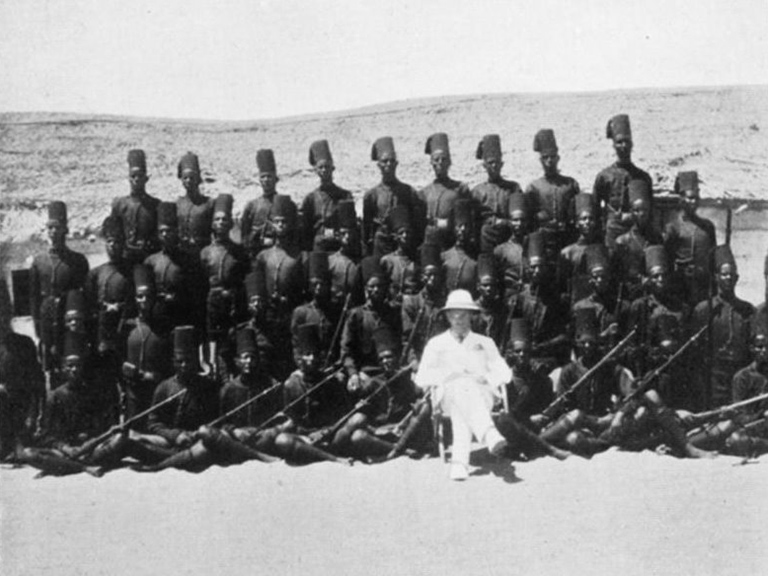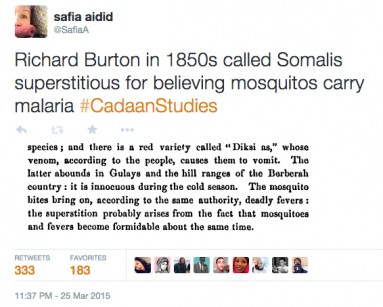What would a decolonized Somali Studies look like?
Burton had arrived in Zeila, his first stop before traveling through the rest of Somaliland and the broader Horn of Africa. He was keenly interested in the culture, beliefs, and practices of the curious “Somali race” that he encountered, and he discovered many things about them. He discovered, for example, that the Somalis of Zeila in 1856 believed that fever was connected to mosquito bites, and he speculated that this “superstition probably arises from the fact that mosquitoes and fevers become formidable about the same time.” He also re-discovered what he already knew: that the difference between “superstition” and “fact” could be traced along racial lines and that knowledge and thought was the realm of the European.
It would not be until 1880 that a French doctor, Charles Louis Alphonse Laveran, would discover the malaria parasite in Algeria, for which he would win the Nobel Prize. Finally, in 1897, a British medical officer in British India, Ronald Ross, would be credited with discovering that malaria was indeed carried by mosquitos.
Burton’s condescension still characterizes the encounter between European and Somali. When ethnographic observation was crystallized as a methodology and a science, only Europeans were seen as capable of the rigorous analysis, reason, and knowledge production it required. Somalis existed only as the backdrop for their intelligence and understanding, as superstitious, irrational, unsophisticated, and unscientific.
#CadaanStudies explores the ways in which these colonial epistemologies continue to be the foundation of the field of Somali Studies. It began in response to the total absence of Somali academics and researchers from the editorial and advisory boards of the newly launched Somaliland Journal of African Studies (SJAS), which claimed to have been founded in collaboration with the University of Hargeisa, since denied by the university. But the hashtag exploded after a member of the advisory board, Markus Hoehne, made his own observations about Somalis:
I did NOT come accross [sic] many younger Somalis who would qualify as serious SCHOLARS - not because they lack access to sources, but because they seem not to value scholarship as such. Sorry to say, but to become a successful political scientist, social anthropologist, sociologist or human geographer, you study many years without an economically promising end in sight. You have to work hard before you get out one piece of text and even then, you often get more criticism than praise. You certainly do not become rich quickly as a social scientist, at least if you have to pay your bills in Europe or Northamerica.
Now, where are all the 'marginalised' Somalis who do not get their share in academia? I guess you would have to first find all the young Somalis who are willing to sit on their butt for 8 hours a day and read and write for months to get one piece of text out. Okay, before you 'crucify' me now for my neo-colonial racist male writing, I ADMIT that given the lack of good quality higher education in social sciences INSIDE Somalia, one cannot enter into a fair competition between cadaan iyo madow [white and black] scholars here. BUT, there are many young Somalis in UK, USA and continental Europe who have a chance to get a degree from a well-established university in social sciences and become master analysts of Somali and other affairs (where are Somali sociologists who work on issues of discrimination or inequality in the USA or Europe, where are Somali religious scholars who engage in the debate about Islam in Europe? Sometimes you have to look beyond your Somali navel). But in my life, I met only very FEW diaspora Somalis who seriously pursued such a career (in social sciences). So, your activism is good, but what you actually would have to do - instead of getting outraged at cadaan scholars, is to sit down and get your analysis out and criticise not cadaan for writing sth, but your own brothers and sisters for not writing better stuff!
Hoehne’s comments offer a unique moment of revelation, but also a window of insight into banal systems of everyday power. They show a mindset in which the Somali is rendered passionately partisan, while the non-Somali researcher remains worldly and detached in his analysis. They highlight a perception of Somalis as too steeped in their Somaliness to objectively assess their own reality. They reveal an understanding of us, the detribalized, tweeting natives of the Somali diaspora, as rebellious, overly emotional and insulting towards the cadaan scholars with which he identifies. They expose the view of Somalis as fundamentally lazy, requiring the non-Somali anthropologist to explain how we can overcome our undisciplined nature through the hard work that we are currently, sadly, incapable of.
As with Burton and the malaria-carrying mosquito, for a European to be unaware of information articulated by Somalis does not indicate his own ignorance. How could it? Somali beliefs are not facts.
Somali Studies was established as a subfield and organization in a time of great intellectual ferment. Publications like Edward Said’s Orientalism and Michel Foucault’s History of Sexuality were in wide circulation by 1980, as were the ideas of Antonio Gramsci, particularly after Raymond Williams began to bring Gramsci’s Prison Notebooks to Anglophone audiences. E.P Thompson’s The Making of the English Working Class had spurred on a variety of new social histories “from below” throughout the 1970s, challenging older, state-centered approaches; by 1979, women’s history had emerged as a field and gender would soon be theorized as an analytical category signifying relations of power in society. Subaltern Studies: Writings in Indian History and Society was launched in 1982, seeking to write histories outside of colonial constructions of knowledge and power.
It was a period of deconstruction and interrogation, of theory and reflexivity. But it did not touch Somali Studies.
I.M Lewis began his fieldwork in the 1950s in British Somaliland, funded by the Colonial Social Science Research Council. His analysis of the Somali clan system—first published in his 1961 book A Pastoral Democracy: A Study of Pastoralism and Politics Among the Northern Somali of the Horn of Africa —continues to dominate understandings of Somali political and social life, despite its flaws. It reduced the complexity and heterogeneity of Somali society as a whole to a monolithic, nomadic pastoralism even though it was based on his fieldwork observations in only one region of Somaliland. His research was firmly embedded in an older tradition of British anthropology and worked to create the fiction of a self-reproducing Somali society, rooted in a rigid kinship system and with traditions unaffected by historical process. It made little sense to ask how clan is a product of modernity and subject to historical process, because Somali society was seen as primordial, outside of history and isolated from the world. He assessed Somali tradition in a vacuum, as though culture and tradition were not being transformed as Somalis were drawn into colonial regimes and a global capitalist economy, the very historical moment that enabled Lewis’ anthropological research in the first place.
He applied his framework to observe the Somali civil war 40 years later: “The political geography of the Somali hinterland in 1992, consequently, closely resembled that reported by European explorers in the 19th century, spears replaced by Kalashnikovs and bazookas.”
A volume of essays on Somali culture, society and politics co-edited by Markus Hoehne and Virginia Luling, which reviewer Gunther Schlee described as a compilation of the “Who’s Who in Somali Studies,” was published in honour of Lewis’ eightieth birthday in 2010. Essay submissions deemed too critical of Lewis did not make it to final publication.
What would a decolonized Somali Studies look like? You can see glimpses of it in the imaginative scope of research conducted by the many young Somalis whose names appear in the collective response to SJAS and Markus Hoehne. Yusuf Dirie engages with subalternity and examines how Western notions of modernity and progress informs debates on pastoralism in the Horn of Africa. There is the reflexive ethnography of Ahmed Ibrahim in his anthropological study of the local production of Islamic orthodoxy in southern Somalia. There is my own research on the affective and imagined geographies of modern Somali nationalism in its historical interaction with the Ethiopian state. Ilyas Abukar intervenes in practices of diaspora and Somali manifestations of blackness among refugees in the United States. Hawa Y. Mire uses art and storytelling to theorize agency and show the multiple ways that Somali women subvert patriarchal discourse.
#CadaanStudies has revealed a Somali Studies in crisis, trapped within a colonial imaginary in a postcolonial, postmodern world. What started as social media discussion has opened up a new space for thinking and theorizing about Somalis, the Somali territories, and the world they inhabit. Its significance will be its call to reimagine the conceptual apparatus of the field, focusing on the systemic level and how it has come to shape academic knowledge production about Somalis and the Somali region. Somali-produced scholarship will be central to academic knowledge, and #CadaanStudies is a disjuncture from which we can begin to theorize and develop new languages and methodologies to describe, analyze and understand new processes, systems, and ways of being. It is time to reimagine a Somali Studies for the postcolonial moment.

